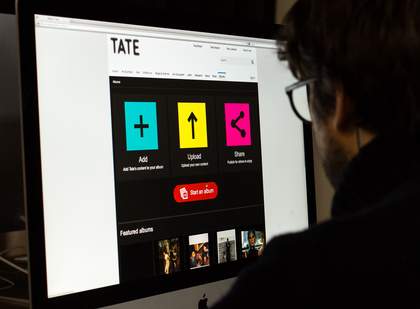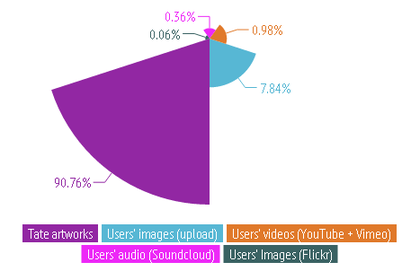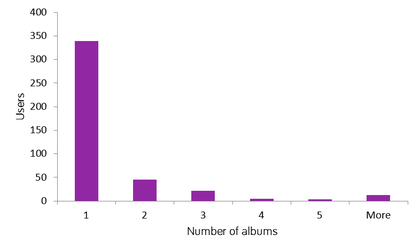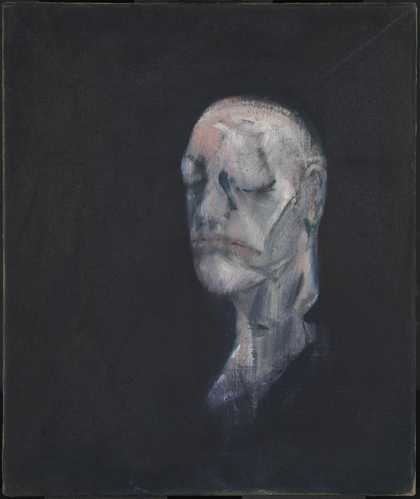We quietly launched our Albums feature in October 2014. Built to support the Archives & Access project , this feature allows users of our website to gather together artworks and archive objects from our collection and save it into an album. Users could then add their own notes, as well as upload their own images, videos or soundworks which respond to the works they have selected. Users then have the choice of keeping the album they have created private; sharing with others via a private URL; or publishing it for everyone else to see their creations. You can read more about the feature here.

User creating an album
The audiences
From the website audience research we have identified four segments that are highly interested in creating an album on our website:
Professional researchers: This segment includes teachers and the tool has been conceived as mechanism to create teaching resources. During a teachers event at Tate, teachers were positive about the privacy features for albums – these were seen as a safe way to share art content, rather than on social media sites where there is no control of the other content, comments and advertising posted.
Student researchers: During the website audience research, 39% of this segment were interested in creating their own albums. This segment could be, for example, those studying art (and related disciplines) or art history and be gathering material to support their course. But the feature could also be used to enable students to think about creating their own portfolios or making connections and curating the Tate collection in a new way.
Personal interest researchers: For this segment – those interested in the visual arts but without an academic or professional connection to the gallery – albums is seen as an opportunity to enable this group to engage and explore more about the Tate collection, gathering together works which interest them or one they would like to learn more about.
Inspiration: For this emotional and aesthetically driven segment, albums could be used as a way to create new and more creative links between collection works. As well as combining different types of content to explore the collection – not just images but also video and soundworks – to create more sensory angles on the collection.
What the data tells us
Although it is still a bit early in the project to make any conclusions, we had a look at the stats of the albums created during the first three months since the launch. Since October, 639 albums have been created, 87% being private albums. This last figure has been quite surprising and we are investigating if it is an usability challenge or actually a feature that users like so they can keep their albums for personal use or to be shared in a small group in a safe environment like schools. There is a positive skewed distribution of the Tate artworks added to albums with some of the highlights of the collection being added by many users such as Weeping Woman, The Snail, Fountain, Metamorphosis of Narcissus or Ophelia. Creating list of Tate artworks is the main usage so far but some users have started to upload their own content being images the most uploaded type so far.

Type of content collected and uploaded by users
Here are some examples of user albums:
- Album ‘Cubist Monsters and Portraits’ which showcases artworks made by school children responding to Picasso’s Weeping Woman
- Album ‘Melankoliset’ which groups worked together on a melancholy theme
- Album ‘Favourites’ which gathers a list of favourites from the Tate collection
html PUBLIC "-//W3C//DTD HTML 4.0 Transitional//EN" "http://www.w3.org/TR/REC-html40/loose.dtd"

Histogram - Number of albums per user
Informal qualitative evaluation sessions
Apart from looking at the numbers we have also run some informal qualitative evaluation sessions to get feedback from the target audiences about their impressions and potential usages of albums.
As already mentioned, we used a teachers’ event to show them the albums and get their reactions to the feature. Albums were seen as a good opportunity to work as a teaching resource – either in the classroom or for a gallery visit – as well as a tool that the class themselves could use to respond to or curate our collection. Finally albums was seen as an opportunity to upload and showcase children’s works as well. Here our privacy features were praised: keeping albums private to a small group as well as been able to turn off comments meant the feature was seen as a safe space to showcase works in an educational context.
Our second evaluation was attached to a workshop in South Wales run by our Learning team. We were able to gather ideas about potential usages of albums, such as recording an artist residency, or an inter-generational projects around memory. We were also able to use this session to informally evaluate how the group used the feature. Here we learnt that the expectation of user-generated content features meant that we have to provide quite an immediate experience: if a user uploads or deletes something from an album, this has to happen quickly. There was also quite a lot of concern about copyright and ownership of content and, while we have the obligatory box to check to say you own the image, people did this without realising what they were doing. To get users to think about it a bit more, we will add a field to the ‘upload content’ form to ask users to add a credit line to their content which acknowledges another maker if it is relevant.
Next steps
These sessions were useful and also highlighted how invaluable it was to carry out qualitative evaluation, even in very informal settings. Our next steps will to be to undertake some formal usability testing evaluate albums, as well as a sending out a survey to all those who have created an album so far to understand how this feature is being used and gather feedback for future improvements.

